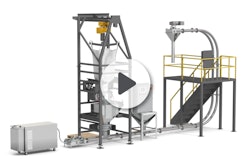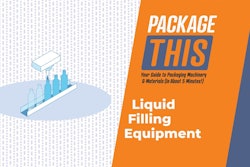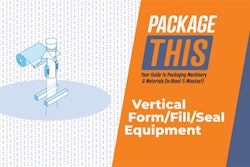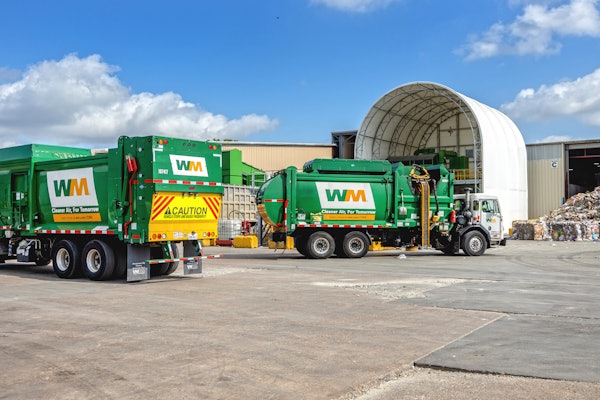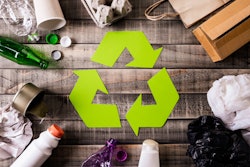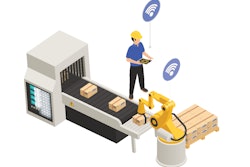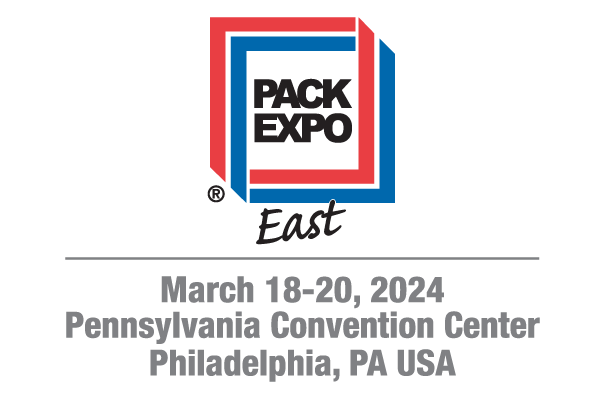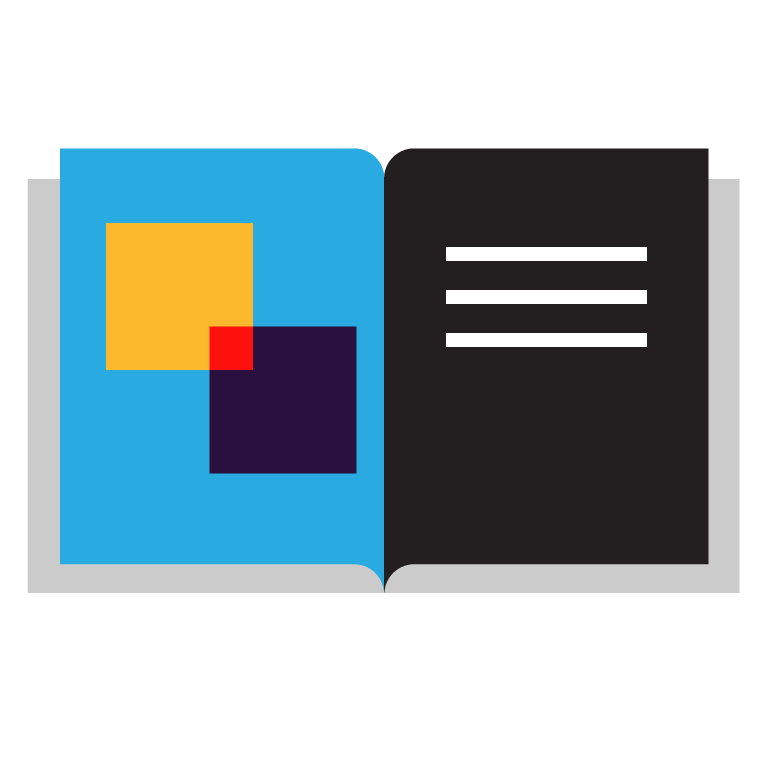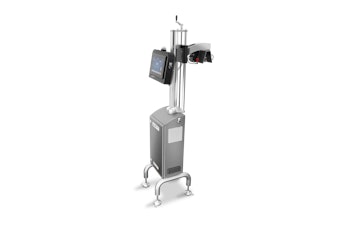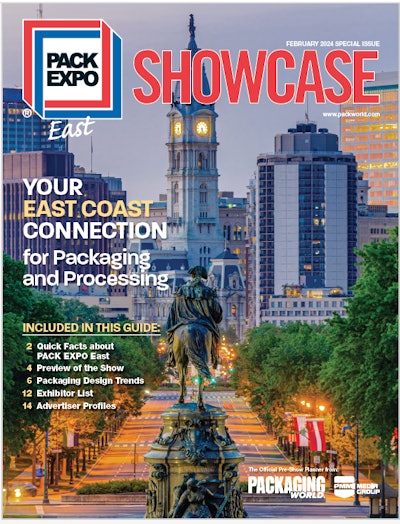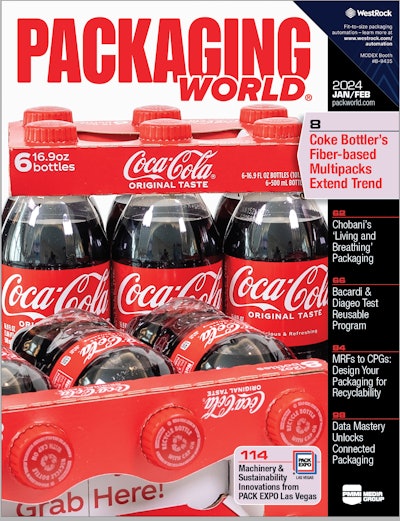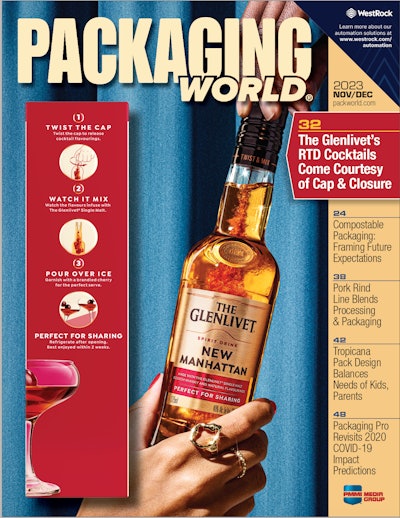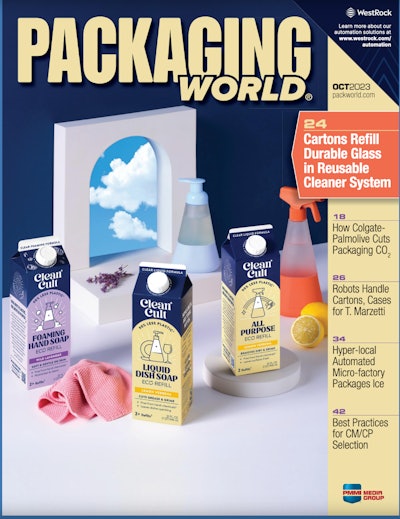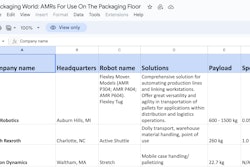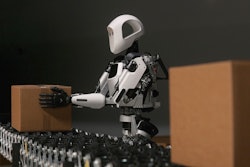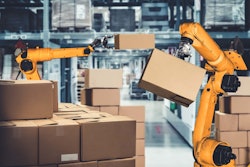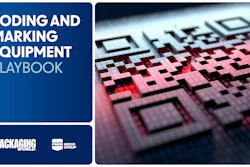As one of the oldest, if not the oldest, packaging materials, paper was also one of the earliest package types to be recycled and is the topic for part three of a six-part sustainability sit-down with Packaging World editors Anne Marie Mohan and Matt Reynolds. Mohan and Reynolds cover sustainability and packaging materials daily for Packaging World. The pair discuss how paper’s relative ease to recycle created growth in its use in place of plastic films and even bottles. Plus, we get to the bottom of exactly what to do with pizza boxes when it comes to recycling.
To subscribe, rate, review, and find more unPACKED podcast episodes, visit pmmi.org/podcast or find us on Apple Podcasts, Spotify, iHeart Radio or wherever you listen to your podcasts.
Sean Riley:
So with all the˙ fancy introductions out of the way. Welcome back to the podcast, Matt Reynolds and Anne Marie Mohan. Welcome Matt.
Matt Reynolds:
Thanks for having me Sean.
Sean Riley:
Welcome Anne Marie.
Anne Marie Mohan:
It's a pleasure to be here.
Sean Riley:
The pleasure as always is all mine. Today we are talking paper based recycling and paper, to me, seems like if it's not the oldest packaging type, it has to be one of the oldest. I can just picture the person going into the general store and picking the thing off the shelf, guy wraps it up in paper and that's their package to go out the door. So I guess now that we're kind of seeing it kind of come back everywhere, it seems like we've gotten away from paper and now we're getting back into it. I have to imagine a reason that we got away from it at a lot of levels was because of some of the limitations with regards to what could go in it, like liquids and oils and things like that. So I guess if could we could just start with talking about what some of the limitations were and how they're being overcome?
Anne Marie Mohan:
Absolutely. You're right about that. As packaging evolved, they started adding a lot of polyethylene coatings to keep out the moisture and adding different barriers to that packaging for shelf life and other functionalities. But companies are really, in their quest to be more sustainable, moving to paper in areas where we would never have thought possible. One recent story that I reported on, which was really fascinating, was Nestle in the UK, they have a very popular product and I haven't had it myself, but I believe it's kind of like an M&M and it's called Smarties and it's a huge brand over there. Very iconic brand, very iconic packaging. And in the past you would have an M&M's package. It was flow wrapped. That was one of their main packages and their goal was to move from plastic to paper. And they have 419 SKUs in all different types of packages.
But the flow wrap was a big one and their goal was to move to paper and have the same shelf life functionality, etc. In addition, they wanted to be able to continue to run it at the same speeds that they were able to run their plastic packaging. So this took several years of development. They were able to make that change. So now they're using a paper package with a water based coating. So it's not affected by the environment, etc, just like plastic would be. And then with some of their other packagings, they had to redesign the formats but tried to keep it as close to what people were used to just because it is very iconic. But that's a great example of a huge shift from plastic to paper.
Sean Riley:
Absolutely.
Matt Reynolds:
I'm sorry to interrupt. Didn't they go from a tube style to a hexagonal tube in some of the smarties?
Anne Marie Mohan:
Yes.
Matt Reynolds:
Yeah. I remember seeing that where you got to balance something that people are used to seeing.
Sean Riley:
That's what my question was. Did they kind of segue to it or was it just like an abrupt shift or alongside it type deal? How did they lay that out from I guess a marketing or a whatever standpoint? Any idea? Was it an addition or a complete move?
Anne Marie Mohan:
It was a complete move across board.
Sean Riley:
Yeah, that's bold. Good for them.
Matt Reynolds:
And it's bold. I mean you mentioned trying to keep up the same speeds. That's really, I mean when you make this kind of shift, you're not just shifting one thing, you're shifting upstream and downstream. So think about another example that, it's another European example, is a Mars company. Mars out of the UK, but this is a biscuit or a cracker or a cookie. I'm not exactly sure. Somewhere in that milieu is called Balisto. Really popular in Germany I guess. It's like a chocolate covered graham cracker kind of thing.
Sean Riley:
Right.
Matt Reynolds:
And they had similar flow wrap packaging that they were using. So they had a pretty big installed base of equipment that was flow wrapping large volumes of this stuff. So when they made the decision to go to a paper based flow wrap, they didn't want to have to gut the entire packaging operation.
So they worked with Syntegon in this case who put together basically a retrofit for flow wrapping machines. So it's almost an off the shelf kind of thing where existing flow wrapping machines, existing install base can be used to make the switch to a paper based printed roll stock, which is of course is a huge cost savings. And then do so without losing the speed of production. And then paper couldn't have done this before because now there's like you mentioned, there's either water based or mineral based, frequently, barriers that are used with in conjunction. I don't know what it was in this case exactly. I know there was a lot of trial and error to get the right paper because that graham cracker and the interior could get a little, I guess stale very easily. Shelf life was a concern.
Sean Riley:
Right.
Matt Reynolds:
But in ways paper hasn't been functional in that milieu you before, it is now. And that's why you're seeing it. It's encroaching on plastic and it's encroaching everywhere. Paper where you've never seen it before.
Sean Riley:
And it's interesting that you note Syntegon, so now you're talking about, which is often what we hear as a problem, not a problem. But one of the difficulties with sustainable type initiatives is that you have to get the OEM involved because we're dealing, as we've said with machines that might be 20, 30 years old. So they have this retrofit now. So I have to think this exists now. If there's other people that are thinking to go down that path that they know now, hey, this is something that's possible. You can get a retrofit for these machines we've used forever to now deal with paper.
Matt Reynolds:
Yeah, we're seeing it on, I mean, paper blister is another big one. PACK EXPO, a few months ago, I can't remember if it was Las Vegas or the Philadelphia show. I think it was Las Vegas, but rower and Starview are coming out, are together with a paper blister, which is ostensibly a blister pack. Imagine batteries hanging up as you're going down the supermarket checkout or something like that.
Sean Riley:
Oh okay yeah. Because I was, when you were saying blister, I was thinking like a pill and I'm trying to figure out how you-
Matt Reynolds:
Similar. Yeah, similar but paper. Luckily this isn't pharmaceuticals in this, but batteries might be good. I think, I can't remember it was Duracell or Energizer was a big splash product not too long ago. And yeah, sensibly, the back card would be supplemented with almost like a thermo formed window kind of holding the product. That can now all be paper and it can be done on the same machinery essentially thermal forming paper. I don't know what the technique is exactly right. But it uses similar molds and similar, so based on the same equipment with some sort of retrofit rotor and Starview have been able to do something like that. And they're not the only ones. I know Sunoco is doing something like that. So you'll be seeing and it's for products that don't necessarily need a barrier. In this case, so I mentioned batteries, we could talk about pens or razor blades, these kinds of things and they can get away with either just like a cutout window.
Sean Riley:
That's what I was just going to say. With something like a battery do you don't really need to see.
Matt Reynolds:
You don't need see it. And in fact you really want a battery nice and wrapped up. But for say a pen, I'm holding a pen now that's got a nifty little rubber. Somebody might want to touch that and see what the hand feel is going to be like. So maybe a small window can accomplish that with just a die cut cutout. And that could be a paper blister and something like that.
Sean Riley:
Interesting.
Matt Reynolds:
It puts a lot of onus on the printed nature of it. So if they need to demonstrate what's in the pack without a clear window, without transparency, then you need to be able to print on the pack, which paper is able to accept too. And a lot of different color, you can beautifully print on it.
Sean Riley:
It's very cool. So I guess we've kind of hit some food things and we've hit some non-food things and that it seems to me the one that we haven't, not haven't, but we haven't touched on is liquids. Is there ways that we can get paper involved with whether it's beverages, whether it's, I don't know, cooking oils, whether it's basically any sorts of things that would be more have moisture involved.
Matt Reynolds:
Well, you can't, and the easiest way is in the secondary packaging honestly. So it bears mentioning anyways that you're seeing what used to be the purview of plastic completely in let's say like a six pack can ring, Oh, something like that. Or a multi-pack. Consider a shrink wrap, multi-pack of tuna cans or any of these kind of secondary packaging. You're starting to see paper there quite frequently. There's a couple examples. Keil clip from graphic packaging. West tracks got a few quite different, similar whether can handles themselves or a multi pack kind of, I think in the case of Heinz beans. So that's pretty robust.
Sean Riley:
Yeah that's a heavy can.
Matt Reynolds:
So maybe a four cans of beans, I can't remember. Maybe a single line of four. A single line of three. So the paper has to be virgin paper in this case if they're always doing the forestry certified to make sure that it's sustainable, it's renewable, but there is some degradation of paper after recycling. The fibers get shorter. It doesn't have quite as much strength. But if you're holding cans of beans or cans of tuna, you're seeing paper in areas where the shrink multi packs aren't there anymore and the can handles can carriers. There's just a big project with West Rock and Modello and Corona down in Mexico I believe that's going on right now. And there was another one, Fish. Fish bone?
Anne Marie Mohan:
Fish bone from Atlantic Packaging that's fairly new. And one interesting aspect of that is that they worked in conjunction, well they first developed the can holder multi pack holder and then they went to serpa to help them engineer the equipment. So I think there are eight or 11 different models depending on the speed that you want to go. And there are a couple different types of this fishbone carrier and it's also made of paperboard and it's covered with the water based coating. So it is recyclable.
Matt Reynolds:
These water based coatings or you mentioned liquids more specifically contact with, we're seeing some thermal form trays. So consider it's not quite liquid, but let's say a salmon filet or something like that. So that's something that we're seeing what used to be a fully plastic thermal form can go to the paper based thermal form.
Now, there's usually, there's obviously some sort of liner there that has to be a liner that X is the barrier. Can't just use the liquid or the water based sealant there. But there's ways that the consumer can remove the liner and then two different waste streams, one for the breaker, right. And then there's the paper based thermal form tray is performing the function of protection and carrying the product itself and you're using that much less plastic. So instead of the full thermal form tray, you just have that liner with the lidding that can be mat, modified atmosphere. It could be a skin pack, vacuum skin pack. So you're starting to see these layers, thin layers of some sort of plastic material act as the barrier. And that gets you into even the craziest, in my opinion would be the paper bottle. The actual, we're talking about liquids, not just the-
Sean Riley:
Yeah, I have a hard time wrapping my head around that one.
Matt Reynolds:
I do too. The real pioneer here I think has been ecologic. And we've done some stories with them. There's been some more recent, I just got an email this morning about a project out of Stockholm, but it's a tequila based paperboard. I haven't, or excuse me, paper bottle. And these are using molded pulp rather than, it's not necessarily a card stock kind of situation. This is a thermal formed pulp around then some sort of liner or bladder that might be on the interior. We're seeing it pop up in airports even.
Sean Riley:
Well now that you're saying that, I know I've seen in CVS, a box of water. How much of that is in line? I mean I guess there has to be some liner in it, but for the majority that's some paper based. Those are paper based, right?
Matt Reynolds:
Yeah we're seeing bag in box quite frequently in for whether it's detergents and so on, but also water or there's even applications in craft beer and so on where you're just reducing the total amount of plastic use. There still has to be some, because obviously it'll be one soggy box if you fill it with liquid, but these are all applications where you're using all the great structural properties of paper and to be able to contain something and lightweight and something that's easily recyclable with a limited amount of plastic footprint on the inside.
Sean Riley:
That kind of answered the question too, because as we're talking about paper, what I'm thinking is the earliest days of when recycling first started becoming a thing that I seem to recall, and this is going to date a lot of us, but really the first things I remember being recycled were your newspapers and the people would put their stack of newspapers out at the curb. So I would imagine the paper was obviously kind of early in the recycling stream. So that's already sort of built up as something that... Now can these be thrown in with that or will it, like you said, certain barriers would have to be removed or for the most part?
Matt Reynolds:
Depends on the application and yeah, it depends on also, I mean consider the pizza box that you get.
Sean Riley:
Always.
Matt Reynolds:
Never know what to do with it because there's oil that gets on there.
Sean Riley:
You guys should know.
Matt Reynolds:
Yeah. But in the case of a liner, no, I know the deal situation is the consumer removes the liner and a lot of these thermal form trays, what is it, graphic packaging is doing that a what used to be AR packaging. Now part of graphic packaging, they're doing a lot of these trays that the consumer then removes the thin barrier liner. And then the external portion is of course then fully recyclable. But of course in the fog of war of cooking, something could happen. But that's the ideal that they're going for.
Anne Marie Mohan:
And I believe that there is technology available now with the paper bottle where they're developing a coating that will allow the bottle for liquids as you were talking at the moment. And then in the case of Smarties, because it's water based coating, it is fully recyclable. So there are examples of that already that can go with your regular-
Sean Riley:
Very nice. So do we have a consensus amongst the three of us about the pizza box? Do we know? We don't know what we're supposed to? Oh, so I thought that that would be one way thing that we could leave you with. But we also are still trying to figure out which stream to put our pizza box in.
Matt Reynolds:
If it comes from Zume which is a company. Z-U-M-E.
Sean Riley:
Z-U-M-E.
Matt Reynolds:
Then you're able to get your Pizza Hut pizza in a box that you can then recycle.
Sean Riley:
So I have to eat at Pizza Hut even though . . .
Matt Reynolds:
Unfortunately, we're here in Chicago and you're stuck with Pizza Hut.
Sean Riley:
Yeah. So we might still, so we'll get back to you. We're going to have a separate podcast on what to do exactly with pizza boxes because we're all still very confused about, unless you have the old school ones that are just the cardboard without the liner, then they can just be thrown away. Thank you Matt. Thank you Anne Marie for coming on here. It was fun time as always. And I'm sure we got some great information out there. We're sorry about not being able to solve the pizza box riddle, but we can't fix everything. Thanks a lot for listening.



